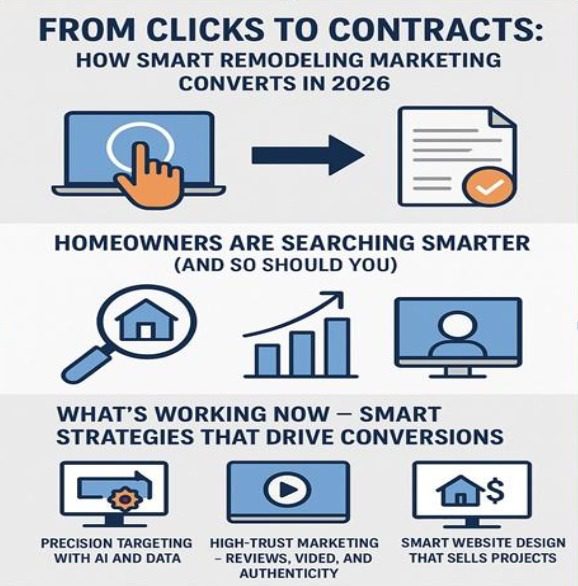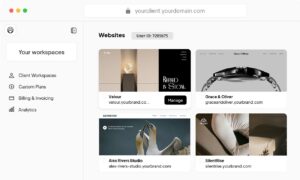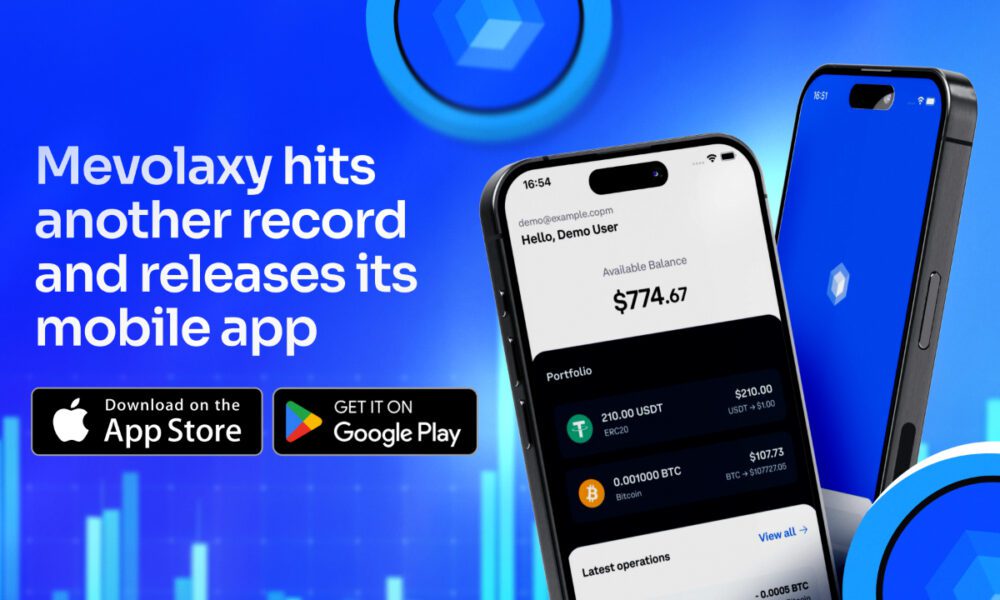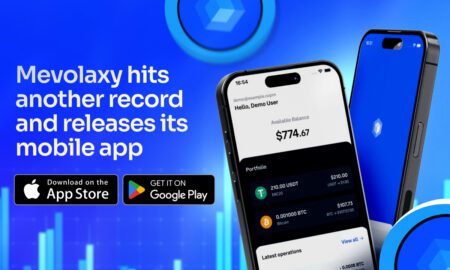250 Las Colinas Drive, Santa Fe, NM 87501
Phone 866-708-1878
Remodeling companies across the U.S. are seeing record digital conversions as homeowners increasingly rely on online research and social proof before booking projects. In markets from Austin to Atlanta, contractors report that up to 85% of their qualified leads now originate from digital channels, a dramatic shift from just five years ago when referrals dominated the industry.
The transformation isn’t just about being online; it’s about being strategic. Today’s successful remodeling marketing goes far beyond basic Google Ads or Facebook posts. Contractors are deploying sophisticated data-driven systems that track every interaction from initial click to signed contract, optimizing each touch point to maximize conversion rates. From AI-powered ad targeting to automated follow-up sequences and digital proposal systems, the remodeling industry has entered a new era of marketing sophistication.
This article explores the key 2026 trends, tools, and conversion strategies that are helping remodeling companies turn online interest into real signed projects. Whether you’re a local kitchen-and-bath specialist or a national design-build firm, understanding how to convert clicks into contracts has become the defining factor between thriving businesses and those struggling to fill their pipeline.
Remodeling Marketing in 2026 – A New Digital Landscape
Homeowners Are Searching Smarter (and So Should You)
The numbers tell a compelling story: over 90% of remodeling decisions now begin with online research, according to recent industry data. Homeowners aren’t just casually browsing; they’re conducting extensive due diligence, comparing multiple contractors, reading dozens of reviews, and educating themselves on costs before ever picking up the phone.
This research-focused, budget-conscious, and trust-driven behavior has fundamentally changed how remodelers must approach marketing. Today’s homeowners arrive at your website already armed with knowledge about materials, design trends, and approximate pricing. They’re looking for validation that you’re the right choice, not just information about what services you offer.
Google’s AI Search Experience has further complicated the landscape for local remodelers. Remodelers SEO services that focused on ranking for broad keywords are giving way to more nuanced approaches. Now, Google’s AI often provides direct answers to user queries, meaning remodelers must optimize not just for visibility but for being featured as the authoritative source in AI-generated summaries. This means creating comprehensive, expert-level content that demonstrates genuine expertise rather than generic service descriptions.
The Shift from “Traffic” to “Intent”
The most successful remodeling companies in 2026 have abandoned the old “more traffic is better” mentality in favor of intent-based marketing. This approach recognizes that not all website visitors are created equal, someone searching “how much does a kitchen remodel cost in Dallas” represents far higher intent than someone simply browsing “kitchen ideas.”
Intent-focused content directly addresses the questions homeowners are actually asking. Rather than just promoting “kitchen remodeling services,” top-performing contractors create detailed guides answering specific queries: “What does a mid-range bathroom renovation cost in 2026?” or “How long does a whole-house remodel take from start to finish?” This content attracts visitors who are further along in their decision-making journey and more likely to convert into qualified leads.
The same principle applies to paid advertising. Intent-based PPC campaigns target long-tail keywords and specific pain points, resulting in higher-quality leads even if overall click volume is lower. Remodelers report that this shift has improved lead quality dramatically—spending less money to attract fewer but better-qualified prospects who are genuinely ready to move forward with projects.
What’s Working Now, Smart Strategies That Drive Conversions
Precision Targeting with AI and Data
Artificial intelligence has moved from buzzword to business-critical tool in remodeling marketing. AI-powered ad optimization platforms now automatically adjust bidding strategies, audience targeting, and even ad creative based on performance data, achieving results that manual management simply cannot match.
Progressive remodeling firms are adopting sophisticated CRM and automation tools like HubSpot, GoHighLevel, and BuilderTrend to manage the entire customer journey. These platforms track every interaction, website visits, email opens, form submissions, and automatically trigger appropriate follow-up actions. When a homeowner downloads a kitchen remodeling guide, the system automatically sends a nurture sequence with relevant case studies, pricing information, and consultation offers.
The results speak for themselves. A mid-sized remodeling company in Phoenix recently reported increasing their return on ad spend by 35% after implementing AI-driven campaign management. By letting algorithms optimize for their highest-value leads rather than just clicks, they dramatically improved both lead quality and conversion rates while actually reducing their overall ad budget.
High-Trust Marketing, Reviews, Video, and Authenticity
In 2026, trust has become the ultimate currency in remodeling marketing. Polished, production-quality advertisements are being outperformed by authentic, sometimes imperfect content that feels genuine and trustworthy. Video testimonials from real clients, filmed on smartphones in actual project spaces, consistently generate higher engagement and conversion rates than professionally produced marketing videos.
Google reviews have evolved from nice-to-have to make-or-break. Contractors with 50+ recent five-star reviews see conversion rates up to 3x higher than competitors with fewer or older reviews. Smart remodelers have systematized review collection, asking satisfied clients immediately upon project completion when enthusiasm is highest.
The rise of “authentic content” extends across all channels. Before-and-after video walkthroughs, client interviews discussing the remodeling experience, and even candid discussions about challenges and solutions build credibility in ways traditional marketing cannot. As one marketing expert notes, “Consumers trust authenticity over perfection.” A slightly shaky video tour of a stunning kitchen renovation, narrated by the homeowner themselves, carries more persuasive weight than any advertisement could.
Smart Website Design That Sells Projects
A high-converting remodeling website in 2026 bears little resemblance to the digital brochures of years past. Speed matters, sites that load in under two seconds convert at significantly higher rates than slower competitors. Mobile-first design is non-negotiable, as over 70% of initial research now happens on smartphones.
The most successful remodeling websites incorporate interactive features that engage visitors and move them toward conversion. Pricing calculators that provide estimated ranges based on project scope help qualify leads while building trust through transparency. Prominent “Get My Estimate” buttons appear throughout the site, making it effortless for ready prospects to take the next step.
Live chat tools, often powered by AI chatbots for after-hours inquiries, capture leads that would otherwise be lost. Comprehensive project galleries showcasing diverse styles and scopes help homeowners envision possibilities while demonstrating expertise. The goal isn’t just to inform—it’s to actively guide visitors down a conversion path.
Turning Interest Into Signed Projects, The Conversion Funnel Explained
Stage 1 – Attract (Clicks)
The top of the funnel focuses on visibility and awareness. SEO-driven content targeting informational queries brings organic traffic, while social media ads, particularly video content on platforms like Facebook and Instagram, capture attention through visual storytelling. Short-form video content, especially reels showcasing transformations and design details, consistently drives the highest engagement rates.
Successful remodelers publish regular blog content addressing common homeowner questions, creating dozens of entry points for potential clients at various stages of their journey. This content compounds over time, building authority and organic search visibility that paid advertising alone cannot achieve.
Stage 2 – Engage (Leads)
Once interest is captured, automated follow-up systems take over. Email drip campaigns nurture leads with valuable content, case studies, and gentle calls to action. SMS campaigns, when permission is granted, provide timely reminders and updates. Chatbots handle initial inquiries 24/7, collecting information and scheduling consultations even when staff aren’t available.
Personalization is key, follow-up content should reflect the specific interests visitors demonstrated. Someone who viewed bathroom remodeling content shouldn’t receive generic kitchen promotion emails. Behavioral triggers ensure that follow-up feels relevant and helpful rather than generic and pushy.
Stage 3 – Convert (Contracts)
The final stage focuses on removing friction from the decision-making process. Digital proposal systems allow remodelers to create professional, branded quotes quickly and track when prospects view them. E-signature tools eliminate the “I’ll mail that back to you” delays that kill momentum.
A mid-size remodeling firm in Texas reported achieving 50% faster close rates after implementing e-signature capabilities for quotes and contracts. By making it easy for clients to say yes immediately while enthusiasm is high, they dramatically reduced the drop-off that occurs during extended decision periods.
Measuring Success – Tracking the Metrics That Matter
Beyond Clicks and Impressions
Vanity metrics no longer cut it in 2026. Successful remodelers track cost per qualified lead, conversion rate from lead to consultation, consultation-to-contract conversion rate, and ultimately, project revenue per advertising dollar spent. These metrics reveal true marketing effectiveness rather than just activity levels.
Quality over quantity has become the mantra. A campaign generating 100 leads at $50 each might seem superior to one generating 30 leads at $100 each, until you discover the first campaign converts at 2% while the second converts at 15%. Tracking lead quality through the entire funnel reveals which marketing efforts actually drive profitable growth.
Tools and Analytics Remodelers Love
Google Analytics 4 provides comprehensive website behavior insights, while call tracking platforms like CallRail attribute phone leads to specific marketing sources. CRM systems like HubSpot consolidate all customer interaction data, revealing which touch points most influence conversions.
The newest frontier is AI-powered analytics that don’t just report performance but actively suggest optimizations. These tools identify patterns humans might miss, recommending budget shifts, audience adjustments, or content topics likely to improve results.
Ready to Turn Clicks Into Contracts?
The digital remodeling race isn’t about who spends more, it’s about who markets smarter. Homeowners are searching, comparing, and deciding faster than ever. Your marketing must keep up.
Remodelers Marketing Crew helps contractors and design-build companies create marketing systems that convert, blending SEO, paid ads, video, and automation to drive measurable results.
Let’s turn your next website visitor into your next signed project. Contact Remodelers Marketing Crew today to start your 2026 success plan.



































